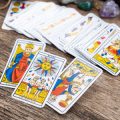Introduction to British Tarot Practice
The art of tarot card reading has woven itself into the very fabric of British esoteric tradition, evolving from its enigmatic continental origins into a practice uniquely reflective of British sensibilities. While tarot first arrived in the United Kingdom as a curious pastime among Victorian spiritualists, it quickly gained traction across diverse segments of society. Today, tarot is no longer confined to parlour games or occult circles; rather, it serves as both a personal tool for self-reflection and a means of communal storytelling. The journey from candle-lit drawing rooms to bustling city workshops mirrors broader cultural shifts—embracing both reverence for historical symbolism and openness to contemporary reinterpretation. Across Britain, from London’s vibrant metaphysical shops to quiet village gatherings, tarot continues to offer insight and comfort, bridging generations and adapting gracefully to the evolving needs of modern life. As we explore the traditional and contemporary spreads used in British tarot practice, it becomes clear that this ancient art remains ever relevant, shaping and reflecting the collective psyche of British society.
2. Defining Traditional Tarot Spreads
Within the landscape of British tarot practice, traditional spreads have long been esteemed for their enduring wisdom and structured approach to divination. Among these, the Celtic Cross and Three-Card Spread stand out as quintessential examples deeply woven into the fabric of British metaphysical traditions. The Celtic Cross, often regarded as a cornerstone of British tarot, offers a comprehensive view of one’s circumstances by examining both visible and hidden influences. Its layout, consisting of ten distinct positions, is designed to unveil the narrative arc of a querent’s journey — from present influences to underlying subconscious currents and likely outcomes.
The Structure of Classic Spreads
| Spread Name | Number of Cards | Key Positions | Typical Use |
|---|---|---|---|
| Celtic Cross | 10 | Present Situation, Challenge, Past, Future, Above (Conscious), Below (Subconscious), Advice, External Influences, Hopes/Fears, Outcome | In-depth analysis of complex life situations or dilemmas |
| Three-Card Spread | 3 | Past, Present, Future or Situation, Action, Outcome |
Quick insights and daily guidance |
Reflecting British Metaphysical Traditions
The enduring popularity of these classic spreads in Britain is not merely due to their practicality but also their resonance with the reflective nature of British spiritual inquiry. The Celtic Cross, for instance, is believed to embody aspects of Celtic mysticism—emphasising interconnectedness between external events and internal realities. Similarly, the simplicity of the Three-Card Spread appeals to the British appreciation for clarity and succinctness while still offering profound insight. Both spreads are frequently employed in settings ranging from intimate parlours to public tarot gatherings across the UK, attesting to their ingrained role within local esoteric customs.
![]()
3. Emergence of Contemporary Spreads
In recent years, the landscape of tarot practice in Britain has evolved remarkably, giving rise to a new generation of contemporary spreads. Unlike the established patterns passed down through tradition, these modern layouts reflect the changing face of British society and draw inspiration from an array of unexpected sources. The influence of pop culture is particularly noticeable; references from literature, film, and even popular television series have inspired creative new spreads that resonate with seekers both young and old. Additionally, the rise of digital communities—forums, social media groups, and online workshops—has fostered a dynamic environment where practitioners freely exchange ideas and experiment with innovative layouts tailored for the modern British experience.
This evolution is not merely aesthetic but speaks to shifting attitudes within society itself. Whereas traditional tarot often focused on fate or destiny, contemporary spreads increasingly address themes such as self-care, mental wellbeing, identity exploration, and personal empowerment. It is not uncommon now to find spreads designed specifically for navigating career changes, embracing diversity, or managing the stresses of fast-paced urban life—issues that are particularly pertinent in today’s UK. In this way, modern tarot reading continues to serve its age-old purpose: offering insight and guidance—yet it does so in a language and form that feels relevant to current generations across Britain.
4. Practical Differences in Application
Within British tarot practice, the practical application of spreads is marked by notable distinctions between traditional and contemporary methods. These differences are most apparent in the approach to interpretation, the settings in which readings occur, and the rituals that accompany each session.
Methods of Interpretation
Traditional British tarot interpretations tend to adhere closely to established meanings, often drawing upon classic texts and oral teachings passed down through generations. This method emphasises a reverence for the symbolic language of the cards, with an emphasis on historical context and archetypal understanding. In contrast, contemporary spreads are frequently more intuitive and flexible, encouraging readers to incorporate personal insight and modern symbolism. Readers may blend various decks or integrate psychological frameworks, such as Jungian archetypes, to enhance their interpretive process.
Comparison Table: Interpretative Approaches
| Aspect | Traditional Spreads | Contemporary Spreads |
|---|---|---|
| Interpretation Style | Fixed meanings, historical context | Intuitive, personalised insights |
| Reference Material | Classic texts, oral tradition | Diverse sources, modern literature |
| Symbolism Usage | Archetypal and fixed symbols | Flexible, open to reinterpretation |
Settings of Practice
The setting in which a tarot reading takes place is also influenced by whether one adopts traditional or contemporary practices. Traditional readings often occur in quiet, private spaces—sometimes within homes steeped in family history or in rooms designated for spiritual work. There is a sense of solemnity and respect for the process. On the other hand, contemporary practitioners might offer readings in public venues like cafés, wellness fairs, or even online via video calls. The atmosphere is frequently more relaxed and accessible, reflecting modern lifestyles and the desire for inclusivity.
Rituals and Preparation
Ritual plays a significant role in distinguishing these two approaches. Traditional practitioners may follow established routines: cleansing the space with sage or incense, shuffling cards using time-honoured methods, and invoking ancestral guidance before beginning a reading. Contemporary readers might opt for simpler rituals—perhaps a brief meditation or setting an intention—and are less likely to observe lengthy preparatory customs. This shift reflects broader trends towards pragmatism and adaptability within British society.
Cultural Nuances in Modern British Tarot Practice
The evolution from tradition to modernity within British tarot is not simply about innovation but also about meeting the needs of present-day seekers. While traditionalists uphold the lineage and gravitas of their craft, contemporary readers embrace diversity and relevance—both approaches enriching the tapestry of British tarot practice today.
5. Cultural and Social Influence
In examining the evolution of tarot spreads within British practice, it is essential to consider the profound impact of cultural values and social changes. Historically, traditional British tarot readings were often influenced by a sense of reserve, privacy, and a preference for structure—values deeply rooted in British society. Spreads such as the Celtic Cross or the Three-Card Spread reflect these principles, offering clear boundaries and a logical progression through ones questions or concerns.
As British society has evolved, especially in recent decades, so too have its collective attitudes towards spirituality and self-reflection. The post-war period saw a gradual relaxation of social norms, encouraging greater openness and curiosity about alternative spiritual practices. This shift paved the way for contemporary tarot spreads to flourish—spreads that are more flexible, introspective, and personalised. Modern practitioners frequently adapt traditional layouts or invent new ones, drawing inspiration from current social movements and individual narratives.
The influence of multiculturalism cannot be understated. As Britain has become increasingly diverse, tarot readers have integrated elements from various traditions into their practice, creating hybrid spreads that reflect the countrys rich tapestry of cultures. This blending honours both ancestral wisdom and new perspectives, allowing tarot to serve as a bridge between different communities and generations.
Social media and digital platforms have further accelerated this transformation. Tarot communities online exchange ideas rapidly, leading to innovative spread designs that address contemporary issues such as mental health awareness, identity exploration, and social justice. These themes resonate with modern British values of inclusivity and self-expression.
Ultimately, the development and usage of tarot spreads in modern Britain is a testament to the nations ability to honour tradition while embracing change. By reflecting both enduring cultural values and dynamic social currents, British tarot practice continues to offer meaningful guidance tailored to the needs of each generation.
6. Conclusion: Bridging the Old and New
In the ever-evolving landscape of British tarot practice, the balance between tradition and innovation stands as a testament to the adaptability and depth of this ancient art. British tarot practitioners are renowned for their reverence towards classic spreads, such as the Celtic Cross or the Horseshoe, honouring the wisdom passed down through generations. These traditional methods offer structure, familiarity, and a sense of continuity—qualities that ground both reader and querent in a lineage of collective insight. At the same time, contemporary spreads have emerged in response to modern questions and lifestyles, reflecting the unique challenges and aspirations of present-day Britain. Whether adapting layouts to explore themes like career transitions, digital identities, or evolving relationships, today’s readers are not afraid to craft new paths within their practice. This blend is not about replacing the old with the new but rather weaving them together with discernment and respect. Through this synthesis, British tarot becomes a living tradition—one that honours its roots while branching out to embrace fresh perspectives. In doing so, practitioners ensure that tarot remains not only relevant but also deeply meaningful for those seeking guidance in an ever-changing world.

